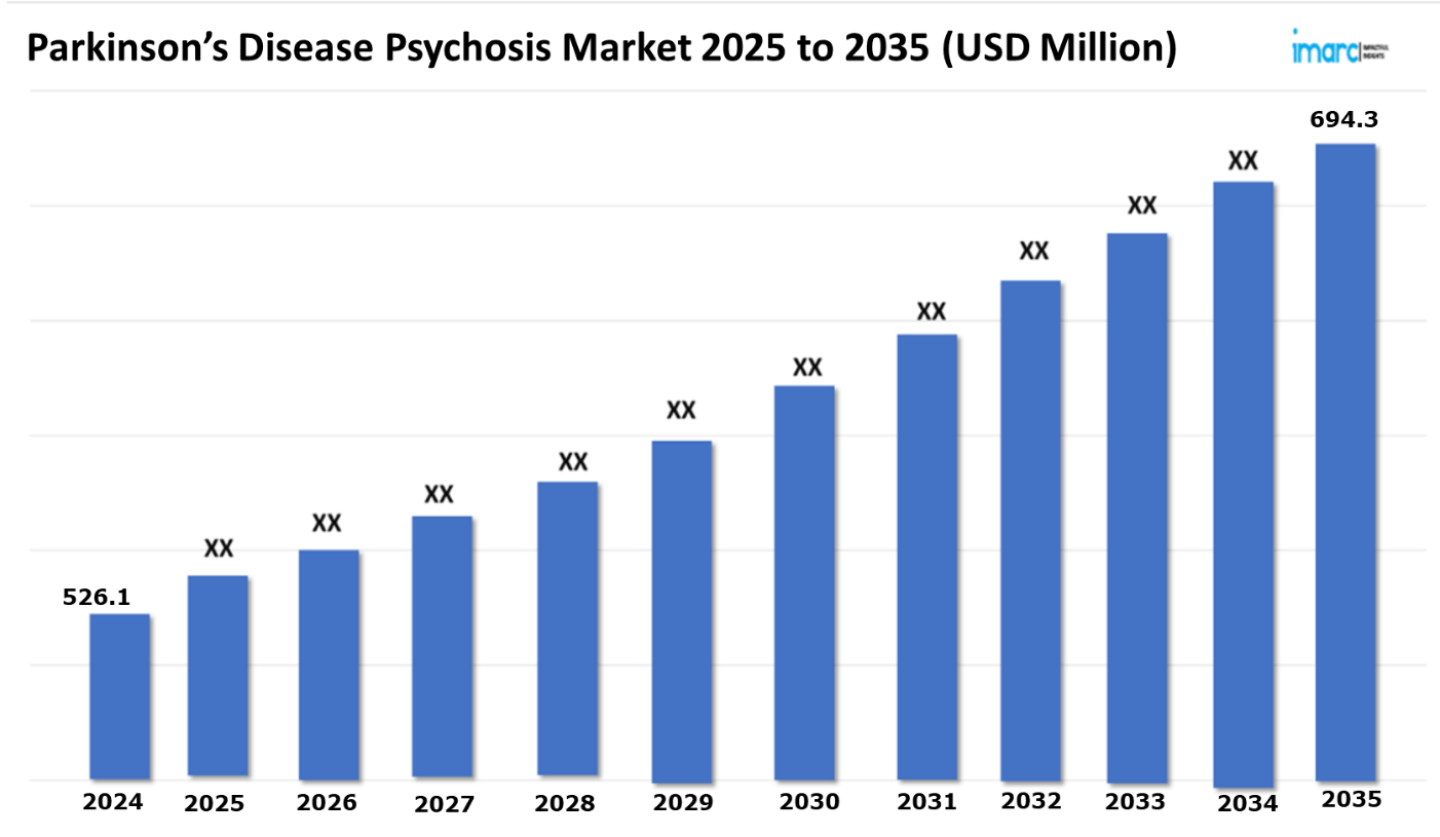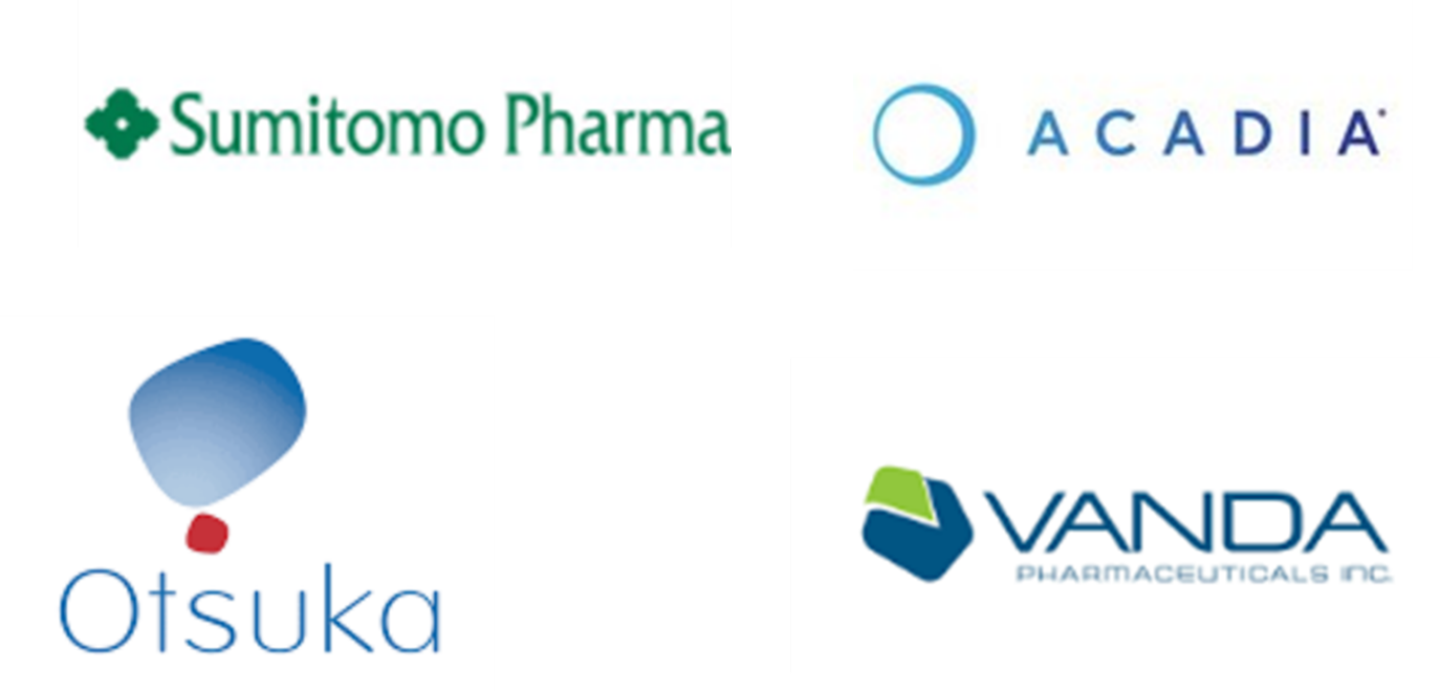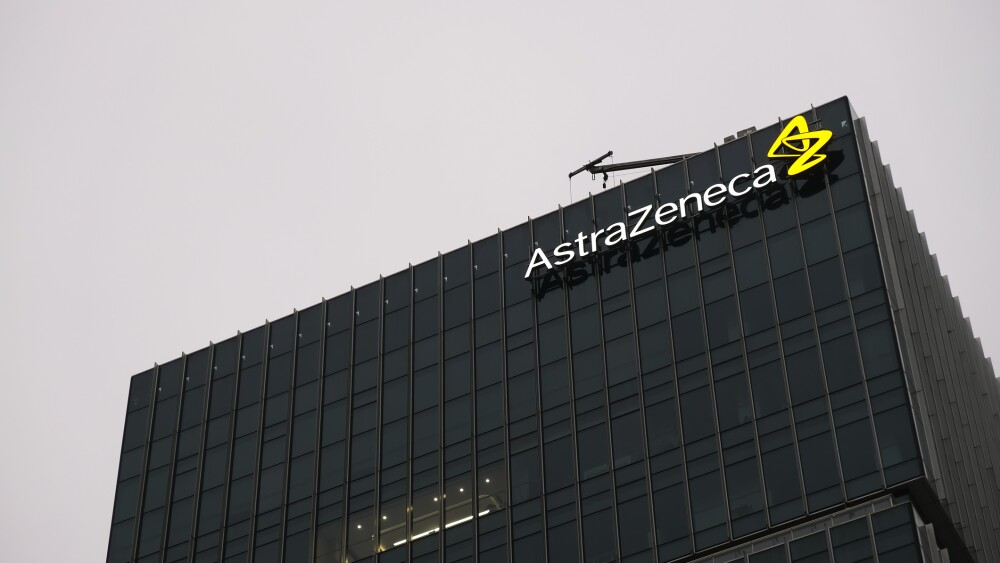Parkinson’s Disease Psychosis Market Outlook 2025-2035:
The 7 major parkinson’s disease psychosis market reached a value of USD 526.1 Million in 2024. Looking forward, IMARC Group expects the 7MM to reach USD 694.3 Million by 2035, exhibiting a growth rate (CAGR) of 2.59% during 2025-2035. The market is driven by the escalating usage of deep brain stimulation techniques, which involve the implantation of electrodes to modulate neural activity and reduce symptoms. Additionally, the development of targeted therapies and innovative treatments is further propelling the market growth.
Advances in Early Detection and Diagnostic Technologies: Driving the Parkinson’s Disease Psychosis Market
The advancements in early detection and diagnostic technologies drive the Parkinson’s disease psychosis market. It leads to earlier intervention and improved strategies for treatment. The most promising advancements include advanced neuroimaging techniques, which include positron emission tomography (PET), functional MRI (fMRI), and single-photon emission computed tomography (SPECT). These imaging modalities give detailed insights into dopaminergic dysfunction, neurotransmitter imbalances, and structural brain changes that characterize PDP, allowing for more accurate diagnosis and monitoring of the disease. Biomarker research has also significantly advanced in the identification of blood-based cerebrospinal fluid and genetic markers that may be indicative of early onset or progression of PDP. With improved identification of α-synuclein aggregates and other neuroinflammatory markers, the ability to differentiate between PDP and psychiatric or neurodegenerative conditions is much easier. The addition of digital health tools like wearable sensors, AI-driven cognitive assessments, and platforms for telemedicine elevates the skills for early detection. Continuous monitoring of behavioral changes, sleep disturbances, and motor fluctuations provides clinicians with real-time data that completes the diagnostic accuracy and personalization of treatment modifications. With these developments, early and accurate diagnosis of Parkinson’s Disease Psychosis is improving patient outcomes, accelerating drug development, and expanding the PDP market. With further research that refines these technologies, the market will be expected to sustain growth as more people become aware, are diagnosed earlier, and have more targeted therapies available.
Request a PDF Sample Report: https://www.imarcgroup.com/parkinsons-disease-psychosis-market/requestsample
Development of Novel Therapies and Pharmacological Treatments: Contributing to Market Expansion
The Parkinson’s disease psychosis market is growing substantially as new therapies and pharmacological treatments are now available that may offer better symptom management with fewer side effects. Most specifically, pimavanserin (Nuplazid) is the very first and only FDA-approved drug dedicated to the treatment of PDP. Unlike traditional antipsychotics, which block dopamine receptors and worsen motor symptoms, pimavanserin works by selectively targeting serotonin 5-HT2A receptors, helping to reduce hallucinations and delusions without impairing motor function. This novel mechanism of action has set a new standard for PDP treatment, paving the way for further innovations in serotonin-based therapies. Other novel emerging treatments include drugs like clozapine and quetiapine, which possess efficacy in treatment but must also be carefully guarded against potential toxicities. Still, more progress is being focused on glutamatergic modulation, treatment with cannabinoids, and neuroprotection for psychoses that target both the primary symptoms of psychotic illness and related neurodegeneration. It also increases patient compliance with treatment by bettering therapeutic benefits, using the development of extended-release formulations, precision medicine approaches, and combination therapies. Thus, this aspect of the management of Parkinson’s disease promises considerable growth for the PDP market as drug delivery systems evolve further, with continuous clinical trials and rising awareness among the populace.
Buy Full Report: https://www.imarcgroup.com/checkout?id=11774&method=809
Marketed Therapies in Parkinson’s Disease Psychosis Market
Nuplazid (Pimavanserin): Acadia Pharmaceuticals
Nuplazid (Pimavanserin) is a medicine that is associated with the management of hallucinations and delusions that are tied to Parkinson’s disease psychosis. It works through treating hallucinations and delusions tied to psychosis in Parkinson’s disease without aggravating the symptoms of motor disturbances since it operates as a serotonin 5-HT2A receptor inverse agonist and antagonist, which preferentially targets these receptors above dopamine receptors. It essentially prohibits heightened serotonin activity at these receptors, which in turn contributes to the symptoms of psychosis.
Emerging Therapies in Parkinson’s Disease Psychosis Market
SEP-363856: Otsuka Pharmaceutical/Sumitomo Pharma
SEP-363856, commonly known as Ulotaront, is a TAAR1 and 5-HT1A agonist. It functions through the activation of these receptors in the brain, unlike most drugs utilized for antipsychotic use, which interfere mostly with dopamine receptors, making it a unique action type among all drugs used under antipsychotic treatment. It is at present being explored to treat patients with Parkinson’s disease psychosis.
Iloperidone: Vanda Pharmaceuticals
Iloperidone is an antagonist of dopamine D2 and serotonin 5-HT2A. It has been proposed that its effectiveness in the treatment of psychosis, such as Parkinson’s disease psychosis, is due to blocking the activation of these neurotransmitters. The simultaneous antagonism tends to reduce the psychotic symptoms and could decrease negative effects compared with the older drugs that acted specifically on dopamine receptors.
Drug Name | Company Name | MOA | ROA |
SEP-363856 | Otsuka Pharmaceutical/Sumitomo Pharma | 5-HT1A serotonin receptor agonists; Trace amine-associated receptor 1 agonists | Oral |
Iloperidone | Vanda Pharmaceuticals | Dopamine D2 receptor antagonists; Serotonin 5-HT2 receptor antagonists | Oral |
Detailed list of emerging therapies in Parkinson’s Disease Psychosis is provided in the final report…
Leading Companies in the Parkinson’s Disease Psychosis Market:
The IMARC market research study incorporates a detailed study of the competitive environment of the market. Many leading companies in the global industry are currently developing integrated platforms to improve the management of Parkinson’s disease psychosis. Acadia Pharmaceuticals is one of the leading companies in this domain. These firms are focusing on innovation in the Parkinson’s disease psychosis industry through ongoing research, diagnostic tools, and product portfolio expansion to cater to the growing demand for the condition.
Request for customization: https://www.imarcgroup.com/request?type=report&id=11774&flag=E
Key Players in Parkinson’s Disease Psychosis Market:
The key players in the Parkinson’s Disease Psychosis market who are in different phases of developing different therapies are Otsuka Pharmaceutical, Sumitomo Pharma, Acadia Pharmaceuticals, Vanda Pharmaceuticals, and Others.
Regional Analysis:
Major markets for Parkinson’s disease psychosis include the United States, Germany, France, the United Kingdom, Italy, Spain, and Japan. According to the estimates by IMARC, the United States has the biggest patient population for Parkinson’s disease psychosis and is the largest market for the treatment of this disease. This can be attributed to the aging population, increased awareness, advancements in targeted therapies, and better healthcare infrastructure.
Secondary to this is the most compelling factor driving the PDP drug market, connected with the achievement of FDA-approvable therapeutics, such as pimavanserin (Nuplazid), that target the serotonin 5-HT2A receptor without deteriorating motor function. The advancement of this scientific innovation has opened a research path and a rich investment portfolio into the next generations of PDP drugs, especially glutamatergic modulators and drugs with neuroprotection and cannabinoids.
Except for these, strong regulations, reimbursement coverages in progression, and penetrations of telemedicine into the U.S. are expanding patients’ access toward PDP diagnosis and treatment. The existence of major pharmaceutical firms and continued clinical trials increases growth and innovation within the market.
Key information covered in the report.
Base Year: 2024
Historical Period: 2019-2024
Market Forecast: 2025-2035
Countries Covered
- United States
- Germany
- France
- United Kingdom
- Italy
- Spain
- Japan
Analysis Covered Across Each Country
- Historical, current, and future epidemiology scenario
- Historical, current, and future performance of the Parkinson’s disease psychosis market
- Historical, current, and future performance of various therapeutic categories in the market
- Sales of various drugs across the Parkinson’s disease psychosis market
- Reimbursement scenario in the market
- In-market and pipeline drugs
Competitive Landscape:
This report offers a comprehensive analysis of current Parkinson’s disease psychosis marketed drugs and late-stage pipeline drugs.
In-Market Drugs
- Drug Overview
- Mechanism of Action
- Regulatory Status
- Clinical Trial Results
- Drug Uptake and Market Performance
Late-Stage Pipeline Drugs
- Drug Overview
- Mechanism of Action
- Regulatory Status
- Clinical Trial Results
- Drug Uptake and Market Performance
Ask Our Expert & Browse Full Report with TOC: https://www.imarcgroup.com/parkinsons-disease-psychosis-market/toc
IMARC Group Offer Other Reports:
Lung Adenocarcinoma Market: The 7 major lung adenocarcinoma markets reached a value of US$ 14.2 Billion in 2023. Looking forward, IMARC Group expects the 7MM to reach US$ 27.5 Billion by 2034, exhibiting a growth rate (CAGR) of 6.23% during 2024-2034.
Dementia Market: The 7 major dementia markets reached a value of US$ 6.8 Billion in 2023, and projected the 7MM to reach US$ 12.8 Billion by 2034, exhibiting a growth rate (CAGR) of 5.85% during 2024-2034.
Mild Cognitive Impairment Market: The 7 major mild cognitive impairment markets are expected to exhibit a CAGR of 4.02% during 2024-2034.
Frontotemporal Dementia Market: The 7 major frontotemporal dementia markets reached a value of US$ 123.8 Million in 2023, and projected the 7MM to reach US$ 596.3 Million by 2034, exhibiting a growth rate (CAGR) of 15.36% during 2024-2034.
Vascular Dementia Market: The 7 major vascular dementia markets reached a value of US$ 2.2 Billion in 2023, and projected the 7MM to reach US$ 3.3 Billion by 2034, exhibiting a growth rate (CAGR) of 3.89% during 2024-2034.
Dyskinesia Market: The 7 major dyskinesia markets are expected to exhibit a CAGR of 3.14% during 2024-2034.
Contact US
IMARC Group
134 N 4th St. Brooklyn, NY 11249, USA
Email: Sales@imarcgroup.com
Tel No:(D) +91 120 433 0800
Phone Number: - +1 631 791 1145, +91-120-433-0800






